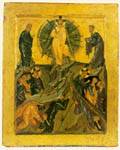|
|
| Portable Icons |
15th c., 2nd half Protaton Wood, egg tempera, 50.5 x 40.5 cm |
|

|
Christ is depicted in a resplendent glory on the top of Mount Tabor. Dressed in white, the standing, full-length figure makes a gesture of blessing with his right hand and holds a closed scroll in his left. On either side of Christ stands a prophet on a rocky peak over a cave, Elijah on the left, and Moses, holding the tables of the Law, on the right. In front of the rocky caves on either side of the peak is shown Christ's ascent and descent of Tabor with his disciples Peter, James, and John (Millet 1916, p. 231, figs. 198, 200). In the lower part of the composition, the three are shown 'falling on their face', overcome by dread at the splendour of Christ's glory and the 'voice out of the cloud'. In the upper part of the icon, on a gold ground, is the inscription: 'The Transfiguration'. The iconographical format, the tight, well-balanced composition, and the figures' intense poses and gestures come directly from the Palaeologan artistic tradition, as reflected in the miniature of the Transfiguration in Cod. Par. Gr. 1242 (1371-5; Galavaris 1995 (2), fig. 224). The Cretan School adopted this format in the fifteenth century (Holy Image, Holy Space 1988, no. 58), and, through Theophanis the Cretan's paintings, it became widespread in post-Byzantine art. From an artistic point of view, the rendering of the faces reflects Palaeologan techniques used in the art of the fifteenth century (Borboudakis 1991, pl. ΚΓ΄); while the rendering of the clothes, with the luminous geometrical highlights, links the icon with techniques of the fifteenth-century Cretan School (Holy Image, Holy Space 1988, fig. 58). In conclusion, this writer is of the opinion that, in his iconographical format and the poses and gestures of his figures, the anonymous painter modelled this Transfiguration on a fifteenth-century work of the Cretan School such as the fifteenth-century icon of the Transfiguration in the Benaki Museum in Athens (Holy Image, Holy Space 1988, fig. 58), adapting it to his own personal artistic idiom.
| |
|
Bibliography: Unpublished.
| ||
| E.N.T. | ||
| Index of exhibits of Protato 15th century |
||
Reference address : https://www.elpenor.org/athos/en/e218ab34.asp